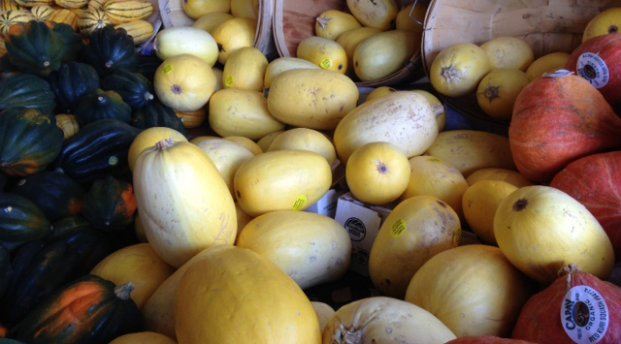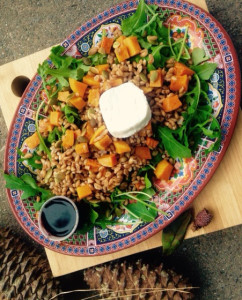The autumn harvest brings us a gift of mellow, sweet orange flesh wrapped up in the hardy skin of the gorgeous gourd.
Winter squashes, such as the emblematic pumpkin, as well as butternut, acorn, kabocha, and many others, offer terrific health benefits. Rich in Vitamin A and beta-carotene (the nutrient associated with that bright orange color), winter squashes help boost your immune system just as the cold season is setting in. They are also anti-inflammatory. While their texture and sweetness signal their starchiness, squashes are complex carbohydrates and carry a low glycemic load. This means that they will not cause a spike in your blood sugar level, but help produce sustained energy.
Don’t be intimidated by that hard shell. It’s worth the time and trouble to get to know what lies underneath. Squashes are planted in the spring, soak up nutrients from the ground and sun all summer long, and then reach their mature ripeness in the fall. Nature’s design ensures that they will feed us throughout the winter months. Stored in a cool, dry place, butternuts and pumpkins can last up to six months.
To break down a tough-skinned squash into cubes for roasting, steaming, or stewing, cut off the top and the bottom, and then peel off the outermost layer. Using a sharp knife, slice the squash in half, then half again. Scoop out the seeds (you can save these to toast!), then cut into wedges or cubes. It’s a good idea to wear rubber gloves for this job—contact with the flesh of the squash can stain and dry out the skin on your hands, if you’re working with a lot of it.
If that seems like too much work, you can bake the squash whole. Wash the skin, and then poke a few holes in it with the sharp tip of your knife. Place it on a baking sheet or in a shallow pan and bake it for 30-40 minutes (depending on the size). When it begins to turn brown, soften and collapse, take it out of the oven and let it cool a bit. Then, you will be able to easily slice through the skin and soft, mash-able flesh.
Keep it simple; add a little butter or oil, a few drops of maple syrup, and you’re set. Or add that mash to some steel-cut oats as they’re cooking. Combine with some broth and herbs, like thyme and sage, and use an immersion blender to create a super-quick, creamy soup.
Here is a wonderful salad to help you enjoy the deep orange goodness of the gourd throughout the winter months.
Farro Butternut Salad
- Farro, cooked
- Butternut Squash, cubed and roasted
- Nutmeg, salt and pepper
- Olive Oil
- Pumpkin Seeds (Pepitas), toasted
- Goat cheese, optional
- Balsamic vinegar, reduced
- Greens, such as arugula or spinach
Farro is an ancient Italian form of wheat, sometimes called “the mother of all wheat.” It has a nutty aroma and flavor, and a very satisfyingly chewy texture.
You can find Farro in different forms—whole, semi-pearled, and pearled. Pearling is a process that will help the grain cook faster. In general, you will want to soak the grain overnight or for at least a few hours, then cook in plenty of salted water as you would pasta. Whole farro will take about an hour to reach an “al dente” texture, while pearled varieties will cook more quickly. Once it’s done, drain, and toss with a little olive oil and let it cool to room temperature. It will keep in the refrigerator for up to a week, ready to be added to salads.
Spread your cubed butternut on a baking sheet, sprinkle with a little nutmeg, salt and pepper, then drizzle with olive oil and toss to coat. Bake in a 350 oven for 30-40 minutes until soft and just beginning to brown. You will need to check it; each squash determines its own cooking time. Let this cool to room temperature. It will also keep for several days in a container in the fridge, or can be frozen for later.
To make a balsamic reduction, just tip a cup or so of balsamic vinegar into a saucepan, and bring it to a simmer. Simmer for 8-10 minutes – being careful not to let it come to a rolling boil—until the liquid has thickened and reduced in volume by half. This, too, will keep in the fridge.
Pumpkin seeds can be toasted in the oven or in a skillet. Keep a close eye on them—you want them fragrant and just beginning to brown a little. In general, nuts and seeds will take on a shiny appearance just before they are ready.
To assemble this salad, arrange a layer of arugula or other dark leafy greens, and then top with farro, butternut and seeds. Add a few dollops of chevre/goat cheese, if desired, and drizzle with balsamic reduction.
Now you not only have a fantastic salad, but a fridge full of ingredients ready to go! Use the squash in a soup or curry. Toss the farro with lemon, grape tomatoes, fresh herbs and feta cheese. Drizzle the balsamic reduction over strawberries or spinach.
Enjoy!
By Lesley Ward: Chef. Writer. Health Educator
Food Coaching with Lesley Ward
Photo credit: Lesley Ward



Write Your Comment
Leave a comment